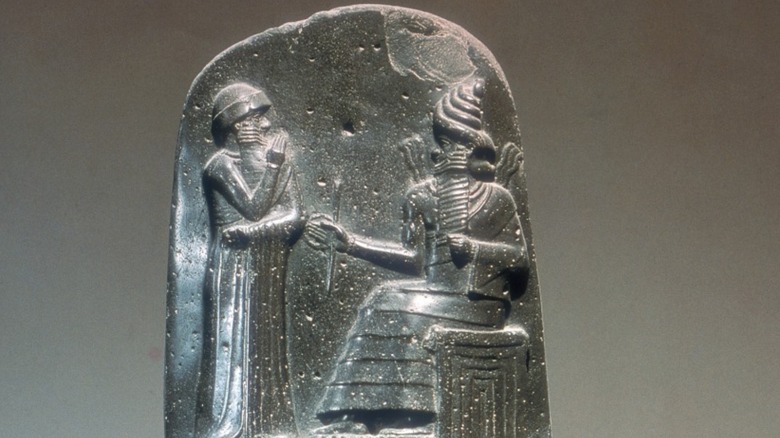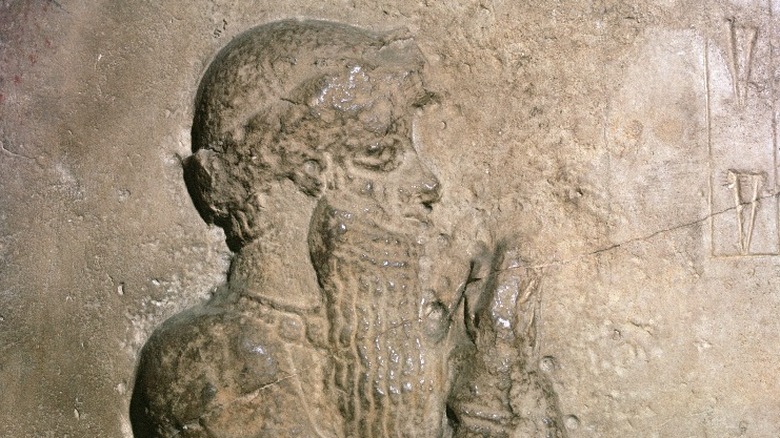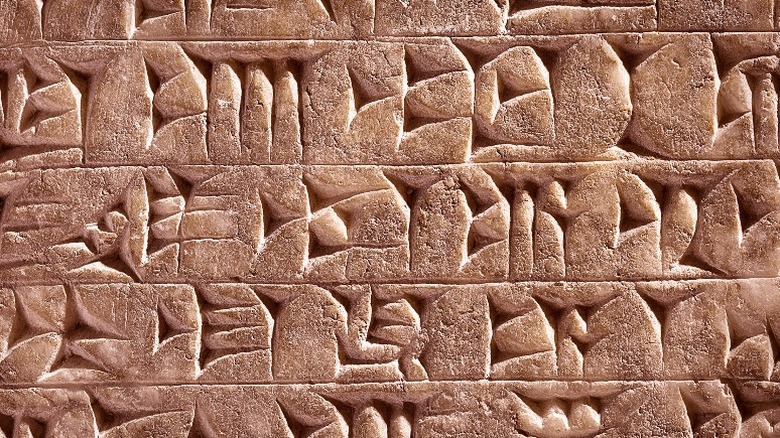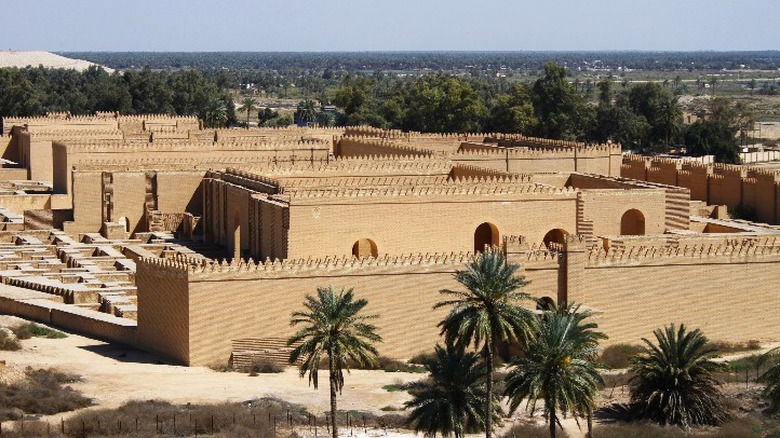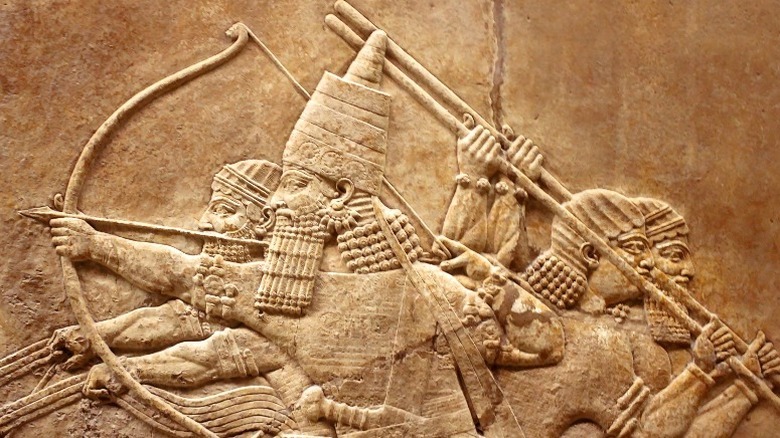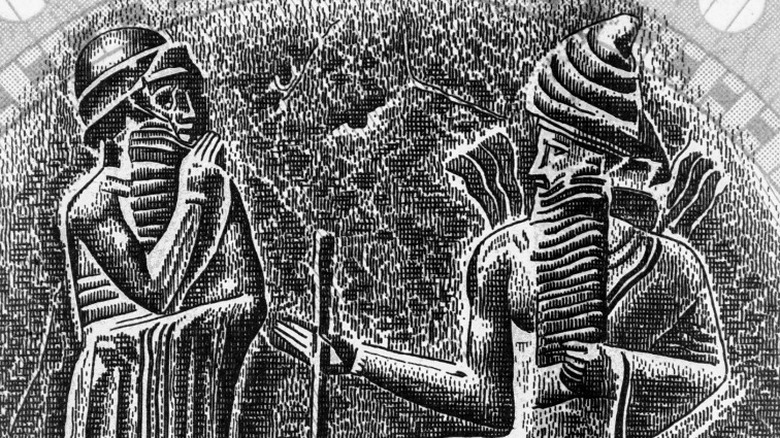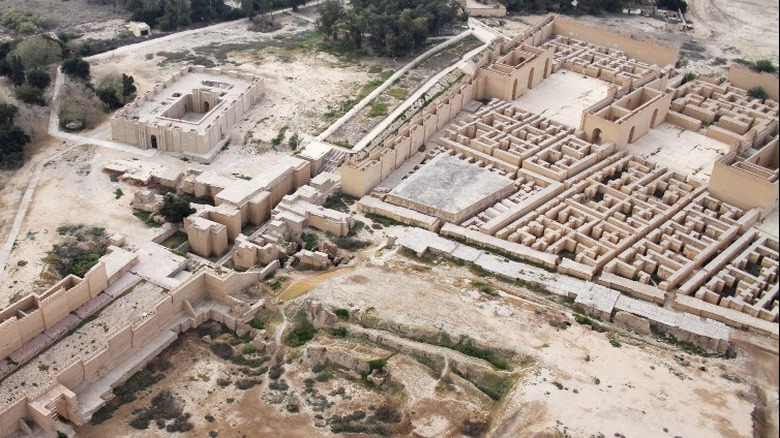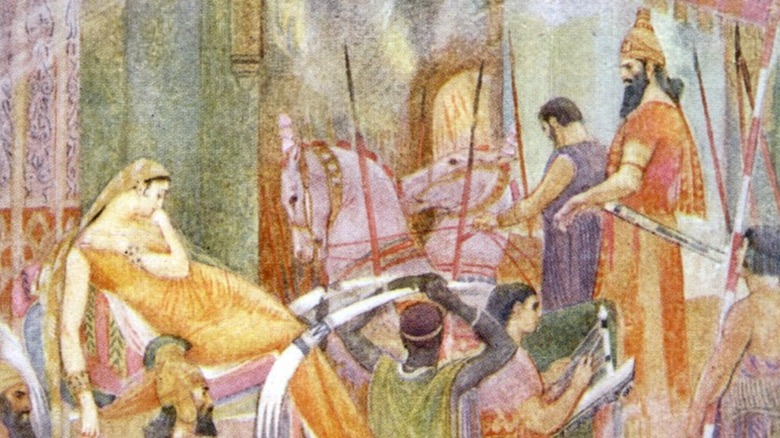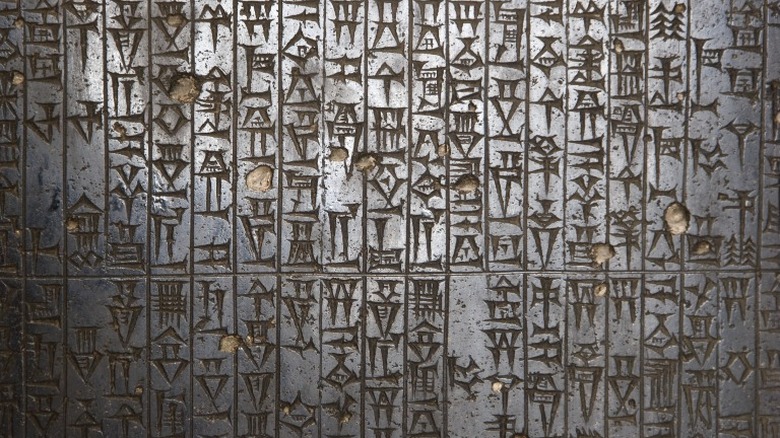The Code Of Hammurabi Finally Explained
The Code of Hammurabi is one of the oldest codes of law that archeologists have found from ancient history. Discovered in modern-day Iran in 1901, this ancient Mesopotamian stone stele dates back to 1,755 B.C.E. and consists of 282 codes of law, according to Biography. The tall black stone was discovered by French mining engineer, Jacques de Morgan, more than 250 miles from where King Hammurabi ruled, according to History.
The laws discovered on the stele vary from general codes of conduct to vicious punishments and give historians a glimpse into an organized society from over 3,700 years ago. The Code of Hammurabi was found broken into three pieces, but its texture and carvings were found beautifully intact — allowing historians to translate its information.
Chiseled into the top of the stele is King Hammurabi with the ancient Babylonian sun god, Shamash. The depiction of Hammurabi and Shamash is significant for many reasons, but one of these reasons is because it shows the relationship between a living king and his god. This juxtaposition illustrates Hammurabi's position as a ruler in society, yet he himself is also being ruled. World History Encyclopedia notes these laws were ordained by the gods, not mere mortals.
With this divine communication, Hammurabi was able to construe his idea of the ideal state and expand his kingdom and reign over a vast majority of ancient Mesopotamia. Hammurabi made sure that his power and presence was recognized all across the ancient lands of the modern-day Middle East, but with his descriptive and vivid code of laws, he would also establish notoriety among the world more than three millennia after his death.
The codes of law were written by an ancient Babylonian king
Hammurabi was an ancient Babylonian king who ruled central Mesopotamia in modern-day Iraq from 1792 B.C.E. to c. 1750 B.C.E. The sixth king of the First Babylonian Empire, Hammurabi wrote laws as a way of implementing justice among civilians, with harsh and often fatal punishments for those who crossed the line. Hammurabi was an adventurous ruler who stretched the city-state of Babylon across the fertile Euphrates River to unite the vast land of Mesopotamia, according to History.
In order to rule over such far-reaching pastures and have control over his subjects, Hammurabi established a judicial policy that would unify his conquered lands and establish order across his empire. According to Britannica, the stone pillar depicts Hammurabi receiving the codes from the sun god, Shamash — the bringer of justice and equity. This transaction of laws and principles between ancient rulers and their kings is a common occurrence across antiquity, notes World History Encyclopedia. Even the ancient Egyptians accepted the gods as the givers of all knowledge, whereas Egyptian pharaohs were the translators of those teachings, acting as a bridge between humanity and divine intelligence. The Code of Hammurabi, however, is one of the earliest examples of this exchange of power between the gods and the human ruler.
The Code isn't the earliest known record of laws
While this stele of laws is over 3,700 years old, the Sumerian Code of Lipit-Ishtar of Isin actually predates the Code of Hammurabi by 200 years, while another code of laws written by the Sumerian ruler Ur-Nammu of the city of Ur dates back to the 21st century B.C.E., according to History, which also notes their resemblance to Hammurabi's code and possible influence.
Ur-Nammu's codes of law were believed to have been rules given by the gods that were then translated by the kings who then transcribed them onto stone, according to World History Encyclopedia. This earliest known judicial system consists of 40 paragraphs that include both laws and punishments — similar to the Code of Hammurabi. Some examples from this first legal system include, "If a man knocked out a tooth of another man, he shall pay two shekels of silver," and "If a man committed a kidnapping, he is to be imprisoned and pay fifteen shekels of silver."
As opposed to the Code of Hammurabi, this earlier stele of laws was less violent and more costly, comprising of fees and fines rather than bloodshed and brutality. Fast-forward a few centuries, and the ancient Mesopotamians are less sympathetic.
Ancient Mesopotamia was the birthplace of writing, astronomy, and law
Mesopotamia, the birthplace of the Code of Hammurabi, was also the motherland of many critical aspects of everyday life, such as writing, science, and law, according to National Geographic's short documentary, "Ancient Mesopotamia 101."
Ancient Mesopotamians also constructed a resourceful mathematical system including the base 60 numeral system, notes National Geographic. This consisted of a 60-second minute, a 60-minute hour, and a 360-degree circular angle. With their advanced understanding of mathematics, the ancient Mesopotamians were also able to use numbers to learn about the stars. By studying the stars, they were able to divide the year up into 12 separate months based on the position of the stars and seasonal changes, according to Britannica.
Furthermore, one of the earliest forms of writing knowns as cuneiform was developed in Mesopotamia around 3,500 B.C.E., according to World History Encyclopedia. With their progressive understanding of mathematics and science, and their ability to build monumental palaces, along with written laws recorded on the Code of Hammurabi, Mesopotamia was truly an advanced civilization that influenced most modern-day practices around the world.
The Code of Hammurabi was created to implement justice in society
The Code of Hammurabi is one of the earliest pieces of evidence of rules related to theft, injury, death, and even women's rights. For example, code 142 states that if a woman wishes to no longer be "possessed" by her husband, her past will be looked into. If it can be proven that the wife "has no vice," and her husband has "greatly belittled her; that woman has not blame, she shall take her marriage portion and go off to her father's house," according to the Code of Hammurabi (via Wright State University).
The Code of Hammurabi also consists of contract laws including building codes, family laws including marriage and divorce codes, liability laws including damage to property, criminal laws including theft and attacks, and economic laws including prices and trading, as well as laws related to the responsibility put on public officials. There are even laws on medical malpractice.
Examples of the laws from the Code of Hammurabi
The laws from Code of Hammurabi are constructed in an "If, then" format. For example, "If X happens, then Y must happen."
To establish a proper trading system, for example, the codes enforce rules for citizens to follow such as, "If a man is in debt and sells his wife, son, or daughter, or binds them over to service, for three years they shall work in the house of their purchaser of master; in the fourth year they shall be given their freedom." In terms of building codes, "If a builder builds a house for a man and does not make its construction sound, and a wall cracks, that builder shall strengthen that wall at his own expense," according to the Code of Hammurabi (via Wright State University).
Fair compensation for jobs was also a top priority for a smooth-running society in ancient Mesopotamia. For example, "If a man hires a field laborer, he shall pay him eight gur of grain per year," or "If a bull has gone wild and gored a man, and caused his death, there can be no suit against the owner." In other words, this particular case may not be strong enough to bring to court.
Examples of the punishments from the Code of Hammurabi
The Code of Hammurabi is one of the earliest examples of the common phrase, "Innocent until proven guilty," according to History. However, there are still hundreds of examples of punishments carved into the Code of Hammurabi that gave law enforcers a guidance system for when they could prove someone's guilt. Examples of these punishments vary and consist of payments, cutting off a body part, and death. As History notes, the guilty often suffered the old adage, "an eye for an eye," with the code providing some of the earliest known examples of the doctrine.
The message of "the truth will prevail" is seen throughout the code. For example, code two states, "If a man has accused another of laying a spell upon him, but has not proved it, the accused shall go to the sacred river, he shall plunge into the sacred river, and if the sacred river shall conquer him, he that accused him shall take possession of his house. If the sacred river shall show his innocence and he is saved, his accuser shall be put to death" (via Wright State University).
However, gruesome punishments await those found in the wrong. In code 282, there is a glimpse into the relationship between masters and their slaves. "If a slave has said to his master, 'You are not my master,' he shall be brought to account as his slave, and his master shall cut off his ear." Similar to the punishment for defying your master, disobeying your parent can also get you into serious trouble. "If a son strikes his father, they shall cut off his hand." The same punishment is also served to a physician who "operates on a man for a severe wound with a bronze lancet and causes the man's death, or destroys the man's eye."
How did the Code of Hammurabi impact society at the time?
The Code of Hammurabi set the tone for how society ought to behave. The laws carved into the stele were intended to influence the morale of the collected people, and its laws were echoed all across ancient Mesopotamia, including Babylon and several other city-states. The strict rules were created to establish order in society with Hammurabi even writing laws so that "the strong should not harm the weak," according to NBC News Learn.
However, historians are still not sure how Hammurabi's severe regulations actually played out in society. According to History, some modern scholars have debated that the codes of laws didn't represent an actual legal system, but rather the stele was created as a propaganda tool to display Hammurabi's hierarchy over his civilians. With harsh and often grim punishments, it's plausible that these codes were a tactic to scare citizens into behaving appropriately.
Whether the Code of Hammurabi was created to protect citizens or scare them, laws put in place by a government are treated the same way even today with the aim of regulating an otherwise chaotic society.
Who was most affected by the Code of Hammurabi?
All citizens had to adhere to the laws, but some people, depending on their class or status in society, paid less for penalties or escaped harsher punishments, according to Britannica. For example, code 198 affirms that "If he destroys the eye of a plebeian [commoner] or breaks the bone of a plebeian, he shall pay one mina of silver," whereas "If he destroys the eye of a man's slave or breaks a bone of a man's slave, he shall pay one-half his price," according to number 199 of the Code of Hammurabi (via Wright State University).
However, rule number 22 of the codes declares that the universal punishment for stealing is death, no matter who you are — "If anyone is committing a robbery and is caught, he shall be put to death," according to the Code of Hammurabi from NBC News Learn.
How did the Code of Hammurabi affect women in ancient Mesopotamia?
With strict codes of conduct and punishments for all, the Code of Hammurabi also tells modern-day scholars about the role of women in ancient Mesopotamia. It's evident from the codes that women held a lower position in society as opposed to men of their similar social status. Although women had some say when it came to divorce, there is evidence of women lacking financial independence and freedom, even in the most bizarre of situations — "If a priestess who is not living in a convent opens a wine shop or enters a wine shop for a drink, they shall burn that woman" (via Wright State University).
Moreover, "If by a blow he has caused a plebian's daughter to have a miscarriage, he shall pay five shekels of silver. ... If that woman has died, he shall pay one-half mina of silver." According to the Code of Hammurabi, the death penalty is issued as compensation if a man has died. However, when a woman dies, the penalty is simply in the form of a fine.
The Code of Hammurabi influenced other civilizations and religions
Other cities and civilizations adapted Hammurabi's laws into their own society long after Hammurabi's era. Versions of the Code of Hammurabi can be traced back as far as 1,000 years after the ancient king's reign, according to History. Even as the government of Mesopotamia changed from city to city, Hammurabi's codes were copied and transcribed, as well as used for testing apprentice scribes (people who could read and write) while training.
Even world religions like Judaism and Christianity applied laws from the Code of Hammurabi into their sacred scriptures. For example, in the Code of Hammurabi, there appears the phrase, "If a man destroys the eye of another man, they shall destroy his eye," which influenced the Old Testament's teachings of "Eye for eye, tooth for tooth, hand for hand, foot for foot ..." as seen in Exodus 21:24.
Why is the Code important to today's society?
The Code of Hammurabi is important to modern-day society because it offers a glimpse into one of the earliest frameworks of laws and legal practices. It reminds the current generation of how similar humans are even with many millennia apart because of how justice is sought.
Moreover, modern-day scholars are also able to recognize that rulers in history also sought to protect their citizens from crime or injustice with laws like those seen on the Code of Hammurabi. This stone pillar tells historians what life was like over 3,700 years ago, but it also paved the way for modern legal practices today with the presumption of innocence and court cases that involved pieces of evidence, as well as witnesses, according to NBC News Learn. For example, the code demonstrates how ancient people could bring their accusations or arguments to a court of law for justice. According to code number three (via Wright State University), "If a man bears false witness in a case, or does not establish the testimony that he has given, if that case is case involving life, that man shall be put to death."
Visitors can see the Code of Hammurabi in the Louvre in Paris
If the Code of Hammurabi could talk, it would be able to tell the story of several critical events throughout history including the excitement surrounding its discovery in 1901. Having being created in ancient Mesopotamia, the stele now resides in the Louvre Museum in Paris — more than 3,000 miles from where it was found 120 years ago.
Not only is this stone pillar of ancient law codes interesting in and of itself as a classical legal system, it's also connected to other historical elements that make it that more fascinating. According to History, scholars believe that the Code of Hammurabi was looted by King Shutruk-Nahhunte during a raid on the Babylonian city of Sippar five centuries after King Hammurabi's reign. Moreover, it's believed that Shutruk-Nahhunte erased some of Hammurabi's laws with the intent to replace them with his own. However, no inscriptions were carved into the stone. This attempt to plunder the code adds more mystery and interest to its history as one of the oldest and most influential law codes.
So, as it stands tall in the Louvre, the Code of Hammurabi represents a vast amount of historical events. From its imagery of legal practices to the power and reign of King Hammurabi to its messages that influenced the Judeo-Christian faith, the Code of Hammurabi truly is an admirable masterpiece of an attempt to create an advanced, protected, civilized society.
